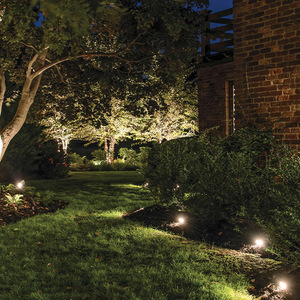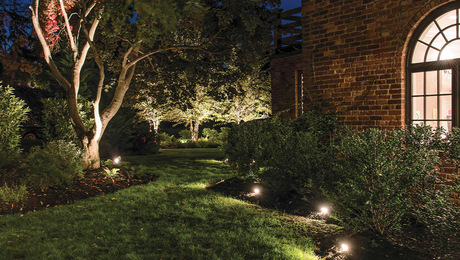Six Bathroom Design Tips
An architect's advice on turning a good master bath into a great bath -- without breaking the bank
In much the same way that the kitchen has become more than just a room to prepare meals and more of a place that accommodates the gathering of the whole family, the master bath has become more than just a bathroom in recent years. How do you make this room a pleasant place to start the day without breaking the bank? I have six suggestions that can help you to plan that perfect bath.
Six bathroom design tips
1. The bath and the bedroom need a comfortable connection
Consider the bathroom in the context of your entire master suite and bedroom floor. The relationship of master bedroom, dressing area, bathroom and entry into the suite from the hallway should be the foremost planning principle. Hire an architect or other design professional to help you. The drawing below shows a bedroom entered from the hall. From the bedroom, you pass through a dressing area into the master bathroom, making the bathroom the farthest space from the entry and, therefore, the most private.
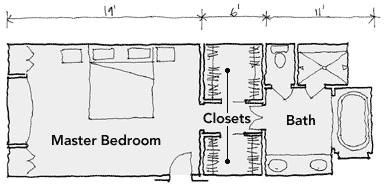
The next plan shows the entrance to the master suite via a dressing room with a bath off a vestibulelike space. While making the bath less private, it allows for one half of a couple to get up, get washed, get dressed and leave without bothering the lucky, still-sleeping other member of the couple.
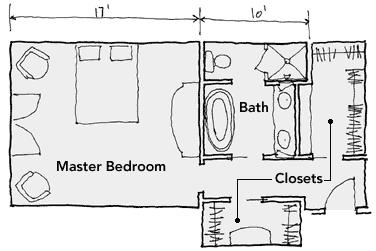
In both schemes, the baths are not the biggest spaces; the bedrooms are. They are big enough but not too big compared with the other spaces. They are adequate and comfortable without being opulent.
2. Designate spaces for specific functions
Design a specific space for each of the most essential functions. For washing, design a contained counter area or a wall against which a sculptural pedestal sink can be displayed. The same holds true for the tub, shower and toilet area. Decide if you really need a separate tub and shower or if a combined/shower tub, or even just a shower, will serve your purposes. Decide if the toilet needs its own room or whether it can be part of the open bathroom. Where fixtures are more artistic, keep some wall space clear so that they can shine.
Try to control growth. If the bath has to grow to accommodate function, keep it to a minimum. For example, in these two central-square plans, adding a bidet to the water closet steals a bit of space from the shower.
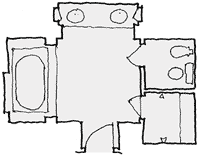 Bath with bidet.
Bath with bidet. 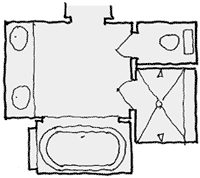 Bath without bidet.
Bath without bidet.
A toilet with its own room does require more space. If space is limited, incorporating a well-designed toilet as a beautiful element in the bathroom itself can help to make the bath seem bigger and airier.
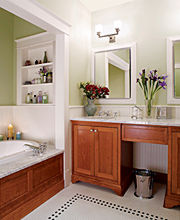 You can give the bath a roomlike feel by organizing its functions around a central space. Here, the tub alcove and recessed lavatory counter show two ways to apply this rule.
You can give the bath a roomlike feel by organizing its functions around a central space. Here, the tub alcove and recessed lavatory counter show two ways to apply this rule.
3. Make your bathroom a room
Don’t line the fixtures against the wall. Instead, organize different functional areas around a central space, and give this space a roomlike feel. Decide on the minimal space you need to move around in, and try not to let that grow. On the facing page are two plans where each function is in its own space, with each organized around a central square.
4. The bath should be an extension of the bedroom
When the bathroom door is open, which it usually is, what do you see from the bedroom? Do you look at a beautiful tub in an arched alcove with a small window facing your thoughtfully manicured backyard? Or do you see a toilet with the seat up? Conversely, carefully consider what you see from the bathroom. While lying in the tub enjoying a good soak, is your main focus the hamper full of dirty clothes, or is it across the bedroom out the window? Use the bathroom to make the bedroom bigger and vice versa.
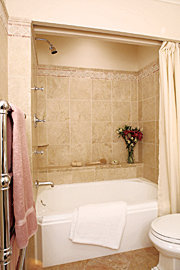 In a small bath, fixtures take on great prominence. A cast-iron tub with faceted corners surrounded by tumbled marble tile distinguishes this bath.
In a small bath, fixtures take on great prominence. A cast-iron tub with faceted corners surrounded by tumbled marble tile distinguishes this bath.
5. Use compatible fixtures and materials
Carefully select fixtures and materials in keeping with your tastes and with the essential character of the house. If you live in a 1920s bungalow, stick with a tile that reflects that period, or use tongue-and-groove beadboard that picks up other features of the home. But don’t make the bathroom the most nicely appointed room in the home. Although it is a place where you spend a lot of time, you entertain there only infrequently. Hire a designer sympathetic to your tastes and to your home. Don’t believe expensive means better. Many beautiful, inexpensive light fixtures, faucets and plumbing fixtures can be used in lieu of the most expensive.
If you fall in love with a particular fixture outside your price range, ask yourself why you like it. Once you identify the qualities that attract you, you can take them to a design professional who can help you to find a similar fixture in your price range.
6. Keep it in proper proportion
Always consider that your design response is proportional to the problem. If you have decided that your tub is a little too small, don’t take away from the master bedroom to make the tub bigger. When you are done planning, look over your bathroom plan. It should be smaller than your bedroom and, ideally, smaller than your dining room. Although you should enjoy being in the bathroom, it should not be the place where you stay all day because the rest of the house is so depressing by comparison.
Don’t let the bath take over; maintain balance in a master suite by keeping the bath smaller than the bedroom. It should be a pleasant space to be in, but the bathroom shouldn’t put the rest of the house to shame. If your available space for the master suite is 15 ft. by 30 ft., don’t make the two rooms equal in size.


If you follow these steps, you will have a master bathroom that reflects your style, that enhances your house and that gives you a reason to get up in the morning.
Stephen Vanze is a principal in the firm Barnes Vanze in Washington, D.C.
Photos: Charles Miller; drawings: Sarah Walther


